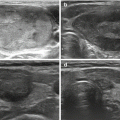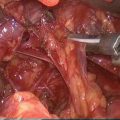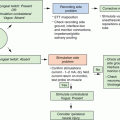© Springer International Publishing Switzerland 2016
Celestino Pio Lombardi and Rocco Bellantone (eds.)Minimally Invasive Therapies for Endocrine Neck Diseases10.1007/978-3-319-20065-1_1616. Minimally Invasive Surgical Techniques: Critical Appraisal and Future Perspectives
(1)
Department of Surgery, University of Pisa, Pisa, Italy
(2)
Dipartimento di Patologia Chirurgica, Medica, Molecolare e dell’Area Critica, Via Paradisa n 2, Pisa, 56124, Italy
16.1 Parathyroidectomy
The possibility of very limited accesses to parathyroid adenomas on one side and the necessity of wide accesses in case of extensive explorations for hyperplasias, recurrent diseases, and carcinoma on the opposite side, has mostly limited the diffusion of endoscopic approaches to hyperparathyroidism (HPT), both primary and secondary. In fact, still the majority of surgeons do favor the so-called minimally invasive parathyroidectomy, which is characterized by an open targeted operation through a small incision [1]. In spite of this reluctance towards the use of endoscopy or other related techniques the minimally invasive parathyroidectomy (MIVAP) [2], which is probably the most widespread endoscopic technique [3], is used by several surgeons throughout the world [4]. Other endoscopic techniques lost most of their appeal either because they implied long insufflations of the neck [5] or because they only offered the chance of exploring one side of the neck due to their lateral access [6].
Moreover, other modalities of treatment have appeared recently such as high intensity focused ultrasound (HIFU) based on the capacity of an ultrasound beam to focus on a target and thus provoking a thermal necrosis of tissues. This technique has already been utilized for several pathologies such as prostate, uterus, pancreas, liver, etc. [7]. This same technique was also attempted in thyroid nodules [8], but the impossibility of having a histological information on these potentially malignant tumors limited very much its diffusion. In fact the parathyroid adenomas, having a very high probability of being benign (at least over 95 %), seemed very good candidates for this kind of nonsurgical treatment of primary HPT, where in most of the cases a single adenoma is involved in the disease [9]. Besides, the idea of treating both PHPT and secondary PHT with nonsurgical techniques had already been successfully established by some AA: the most popular being radiofrequency thermal ablation [10], ethanol injection [11], and ultrasound-guided laser thermal ablation [12]. All these technologies proved to be effective but they were used only sporadically in the treatment of HPT [9–12]. Alternatively, HIFU, which had proved to be so effective in treating some tumors of parenchymal organs, raised a great expectation in the field of parathyroid adenomas (PA), at least in their sporadic form [9].
In a pilot study set up by our Group [13] though, it was certainly possible to demonstrate the effectiveness of the procedure, but its safety was far from being ascertained: in fact, although the necrosis of the tissue was evident, and so was the stop of the hyper secretion of parathyroid hormone, also evidenced by both quick parathyroid hormone assay (qPTHa) and postoperative sestamibi scan in 3 out of 4 cases, a transient palsy of recurrent nerve was present. The latter lasted for few days, but it was considered as an intolerable complication rate and the study was interrupted. In spite of this disappointing result it cannot be excluded that with an appropriate refinement of this technique, when applied to PA, its side effects could be easily minimized. The problem of the relevant transmission of heat linked with any of the energy devices quoted above is consistent with the proximity of the recurrent nerve to PAs and cannot be by-passed, but some expedients could certainly improve the results in a significant way. A new assessment of the quantity of energy used on parathyroid tissue is necessary together with a better selection of patients: in order to reach this goal, it would be necessary to work out with more accuracy the presumed distance between adenoma and nerve, perhaps selecting only few inferior and anterior adenomas. Another issue to reduce the amount of energy could be to increase the number of sessions so as to use less energy during each application [13].
Once the criticism towards these minimally invasive techniques in parathyroid surgery has been expressed, the question to be addressed is: Can these approaches be considered still valid for the treatment of PHPT and which are their limitations? No doubt that all the nonsurgical approaches find a very limited application: probably they will remain an option only in cases where severe contraindications for surgery do exist; an example might be serious cardio vascular or respiratory diseases in elderly patients or advanced neoplastic patients who can sometimes present with a PHPT. Also serious renal insufficiency cases can occur with SHPT and even more with Tertiary HPT and these could be good candidates for such alternative techniques [10].
A further consideration though must be done for the general indications in PHPT surgery: most of the patients are now referred to the surgeon with a very clear indication and, above all, with a very accurate preoperative localization: which with a high degree of probability means the patient presents a sporadic adenoma [14] and no extensive exploration will be necessary. Then the effort to minimize the invasiveness of the surgery in all these cases, which besides represent the large majority of patients, has been widely justified, also making the standard open parathyroidectomy easily accessible for any surgeon: no doubt this operation can be performed through a small incision, using a lateral focused access, possibly facilitated by the use of qPTHa and this explains why it has been so successful [1, 2].
Considering this background, what might be the role today for MIVAP? In fact this is an operation which needs a learning curve [15] and a certain familiarity with the endoscopic procedures. According to the opinion of several AA [16–18] though, some important advantages are still evident in MIVAP. One of the most important to us is the possibility of exploring both sides [19] since this operation uses a central neck access; although this necessity quite rarely occurs, a bilateral exploration can prove to be of paramount importance in few selected cases. Also the possibility of performing the operation under local anesthesia makes MIVAP highly challenging when the surgeon has to choose a minimally invasive parathyroidectomy [20].
In conclusion, this operation which also has the great merit of having opened the way to all endoscopic surgery of the neck, after more than 20 years of life seems to be far from being abandoned, and, I would say, is here to stay.
16.2 Thyroidectomy
Traditional thyroidectomy is realized through a transverse cervical incision (Kocher’s incision), and is associated with a very low morbidity and mortality rate. However, the scar remaining after the procedure, in such an exposed area as the neck, is disliked by many patients, also considering the main target of thyroid diseases: the female population. Therefore, in the early 1990s, after the introduction of laparoscopic/endoscopic surgery, which changed very quickly the attitude of many surgeons towards their operative behavior, countless new mini invasive techniques were soon proposed for almost any field of surgery and it was not difficult to imagine that endocrine surgery would not escape this fate.
The first report of an endoscopic parathyroidectomy was in 1996 by Gagner [5], even though a totally endoscopic approach soon appeared too technically demanding if compared to the simple standard parathyroidectomy. One year later, minimally invasive video-assisted parathyroidectomy [MIVAP], a gasless video-assisted technique firstly described in Italy [3], showed optimal results in a large series, concerning cosmetic and postoperative outcome. Following these encouraging results obtained by MIVAP, surgeons were pushed to try the same access and the same technique also for operations on thyroid [21] and first series of patients successfully undergone minimally invasive video-assisted thyroidectomy (MIVAT) were published [22]. In the mean time and for the following 10 years, several surgeons from different parts of the globe, aiming to give patients best cosmetic result a postoperative course, continued to devise and propose different endoscopic approaches for thyroid removal, describing remote accesses from axilla [23], breast [24], retroauricolar, or even mouth [25, 26].
In the last 5 years, also robotic thyroidectomy, both transaxillary and retroauricolar were described and they seemed to make improvements to the previous approaches by the endoscopic access, although with higher costs, longer operative time, and risk of new complications [27].
Attempting to classify all the approaches proposed for thyroidectomy in recent years, both minimally invasive and cosmetic, we could divide into two main classes: cervical and extracervical or “remote.”
About cervical approach, the endoscopic approach proposed by Gagner and later by Henry has not been successful and were quickly abandoned. They were purely endoscopic, lateral approaches, based on Co2 insufflations. MIVAT instead, gasless technique, has been successful and spread among surgeons thanks to the low difficulty of execution, low cost and optimal cosmetic result combined with short and good postoperative course.
Briefly MIVAT can be described as follows: the patient is placed in a supine position without extension of the neck. A 1.5 cm incision is performed two fingers above the sternal notch. The midline is opened for 2–3 cm and strap muscles are dissected from the thyroid lobe and loaded by a small retractor. Once the thyroid lobe is completely freed from the strap muscles, larger retractors, “army-navy” type, are inserted in order to maintain the operative space during the entire procedure. At this point a 5 mm 30° endoscope is introduced together with other endoscopic instruments and the procedure becomes totally endoscopic. All vessels are sectioned by means of energy device (ultrasonic, radiofrequency) except vessels very close to the nerve when, in order to avoid thermal injuries, disposable titanium clips are preferred. Recurrent nerve and parathyroids can be easily identified and dissected thanks to the magnification of the endoscope.
Once the thyroid lobe is completely freed and all critical structures identified and preserved, it is delivered starting from its upper pole. Then, under direct vision, the Berry’s ligament is sectioned and the lobe is completely freed and resected. Drainage is avoided. The midline is closed with a single stitch and skin glue is used for the wound.
MIVAT is indicated in patients with nodules less than 3 cm and thyroid volume less than 25 ml. This allows treating patients with small multinodular goiters, nodules microfollicolari, graves, toxic adenomas, and even low-risk papillary carcinomas. Numerous publications demonstrate that MIVAT is a safe technique, with excellent cosmetic results and excellent postoperative course. Moreover, MIVAT has proven effective in the treatment of papillary carcinoma, as demonstrated by comparative studies between traditional thyroidectomy and MIVAT. In these studies the clearance at thyroid bed level and outcome of patients undergoing these two different techniques were the same. Two main studies from Pisa clearly demonstrated the efficacy of MIVAT for papillary carcinoma. The first one is a prospective randomized study [28]: 35 patients with low-risk papillary carcinoma were allotted, 16 were operated on with MIVAT (group A), and 19 with conventional technique (group B). One month after surgery thyroglobulin (Tg) serum level was measured and a whole body scintigraphy (WBS) with I131 was performed in all patients and no statistically significant difference in the results between the two groups was found.
The second prospective study [29] involved 221 patients with a papillary carcinoma smaller than 30 mm, treated by MIVAT or traditional thyroidectomy. After a mean follow-up of 5 years there were no statistically significant differences between the two groups in terms of age, sex, and mean follow-up. No differences in serum Tg and TSH levels and 131-I neck uptake were observed between the two groups of patients and no statistical difference was found between cured and not cured PTC patients at the end of follow-up. Same rates of hypoparathyroidism and/or recurrent laryngeal nerve palsy were recorded. These results after 5-year follow-up clearly suggest that MIVAT is a safe and effective technique in the treatment of low and intermediate risk papillary carcinomas.
The limits in the indications represented by thyroid volume and diameter of the nodules are probably the greatest limit of MIVAT, which in fact can only be performed in 15 % of patients with thyroid disease.
Despite this, MIVAT represents the most minimally invasive endoscopic technique performed in the western countries, as demonstrated by numerous publications that have appeared in the literature in recent years.
During the last 2 years more than 30 papers dealing with MIVAT appeared in the indexed literature, while 18 papers were published during 2008 and 11 during 2007. These data witness the great interest for video-assisted surgery of thyroid among the surgeons and how it became widespread, not only in Europe but also in the United States. According to Terris, “the technique most widely practiced in North America is … MIVAT as originally described by Miccoli” [30]. When dealing with this operation several outcomes might be considered in order to critically appraise its results: Sgourakis et al. [31], for example, distinguished between primary and secondary outcomes: among the first ones they put adverse events and cosmesis, while among the second ones operative time, early and late postoperative time were considered. Others took also on account the hospital stay length. An attempt will be done in this chapter to examine the overall results as they emerge both from the most recent literature and from our personal experience.
To the best of our knowledge only two main reviews [31, 32] have been published aiming to give an evidence-based information on MIVAT: both of them are concordant on a statistical significance in favor of MIVAT versus traditional thyroidectomy when cosmesis and postoperative pain are examined. As far as adverse events are concerned it appears evident in these, as in almost all the papers dealing with MIVAT, that a statistical significance is impossible to reach due to the very low number of complications, in particular recurrent nerve palsies and hypoparathyroidism. In spite of the lack of a statistical significance though, all authors are concordant on the absolute safety of this procedure with respect to conventional surgery.
Stay updated, free articles. Join our Telegram channel

Full access? Get Clinical Tree






